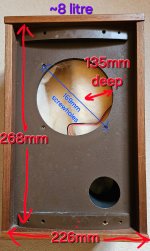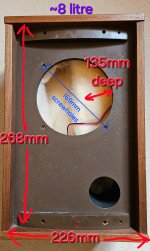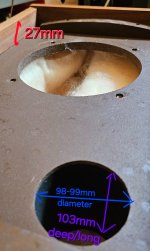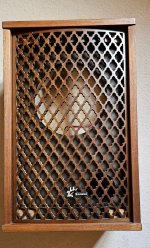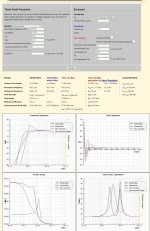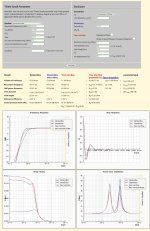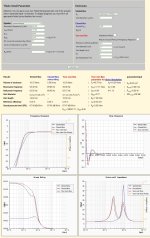Hello DIY audio. Long time reader, first time poster. Please be kind 🙂
I have a thing for the vintage aesthetic. I love how old gear was made with love, is repairable, has lasted 50 years+, is a form of recycling. Etc etc. That said, although I have experimented happily with many old speakers, its more the amplifiers & receivers that i actually listen to (with newer speakers).
Recently I bought some Sansui SP-25 wooden lattice speakers for £30 all in with one driver open circuit. I deliberately bought them like this in order to update with a nice full range driver, so that i can enjoy the vintage look, while pleasing my ears.
Firstly i have never built any speakers. I am a novice. I do know there will be compromises. The lattice will create reflections, which I can live with, I am more worried about that 27mm baffle lip. Perhaps I can line it with felt?
Driver suggestions please! And any tips or tricks that might lessen the existing boxes shortcomings!!
Please see photos attached for internal / relevant dimensions etc.
I look forward to any help!
I have a thing for the vintage aesthetic. I love how old gear was made with love, is repairable, has lasted 50 years+, is a form of recycling. Etc etc. That said, although I have experimented happily with many old speakers, its more the amplifiers & receivers that i actually listen to (with newer speakers).
Recently I bought some Sansui SP-25 wooden lattice speakers for £30 all in with one driver open circuit. I deliberately bought them like this in order to update with a nice full range driver, so that i can enjoy the vintage look, while pleasing my ears.
Firstly i have never built any speakers. I am a novice. I do know there will be compromises. The lattice will create reflections, which I can live with, I am more worried about that 27mm baffle lip. Perhaps I can line it with felt?
Driver suggestions please! And any tips or tricks that might lessen the existing boxes shortcomings!!
Please see photos attached for internal / relevant dimensions etc.
I look forward to any help!
Attachments
My initial thoughts are the Alpair 11ms, because several designs I've seen suggest good results with 9 litres, although I calculated my box having 8.176 (or similar, not including cone displacement)... However the negative camber and my baffle lip - would this choice exacerbate issues?
It also fits nicely in place of the existing driver.
I am prepared to mess about with using a smaller driver, and installing it on a new baffle affixed to the existing... raising the cone from the baffle by whatever thickness I attach it to, eg 12mm.
But I am unsure if this will result in more or less baffle issues?
It also fits nicely in place of the existing driver.
I am prepared to mess about with using a smaller driver, and installing it on a new baffle affixed to the existing... raising the cone from the baffle by whatever thickness I attach it to, eg 12mm.
But I am unsure if this will result in more or less baffle issues?
Measure twice, cut once...Whoops! They are 368mm tall inside measurement, so please IGNORE 8 LITRE - THEY ARE 11 LITRES!!
Apologies!
Apologies!
Given the edge reveal of those boxes, a wide dispersion driver like a Coax isn’t a good idea……..but a full range which will narrow and beam is fine……it won’t really see the sides of the box.
Part of the decisionmaking process should be determining what aspects of performance are important to you/how the speakers are going to be used.
If you are more of a casual listener that wanders around the room and wants good sound no matter your position, the coaxial may make more sense. It has the potential for much better/more even dispersion across the upper frequency range.
I would consider edge diffraction/reflection issues more for someone that's into imaging/purist pursuits, which generally lean toward one optimal listening position. For casual listening, they are less important.
If you are more of a casual listener that wanders around the room and wants good sound no matter your position, the coaxial may make more sense. It has the potential for much better/more even dispersion across the upper frequency range.
I would consider edge diffraction/reflection issues more for someone that's into imaging/purist pursuits, which generally lean toward one optimal listening position. For casual listening, they are less important.
Great. Further impetus to follow the fullrange idea! To begin with they will definitely be for fixed position listening. I have a small office, 3.1m wide by 2.6m deep. So nearfield listening really.
I alternate 2 sets of speakers between desktop duty (0.9-1m to ears) in front + sub, and stand mount each side and in front of me (1m10 to ears). Currently Monitor Audio Ref PMC 700 on the stands, which are super nice.
Although large, these will likely go on the Desktop to begin. In the future one pair of these will migrate to a 5.5m x 4m lounge.
I alternate 2 sets of speakers between desktop duty (0.9-1m to ears) in front + sub, and stand mount each side and in front of me (1m10 to ears). Currently Monitor Audio Ref PMC 700 on the stands, which are super nice.
Although large, these will likely go on the Desktop to begin. In the future one pair of these will migrate to a 5.5m x 4m lounge.
That was my immediate thought as well. Will they physically fit without too much cutting?My initial thoughts are the Alpair 11ms
jeff
Hi Jeff, Yessir! Pretty neat fit, just new holes to drill, and in she goes 🙂
I was originally worried about the negative camber and my edge reveal reflections, but other posters suggest less of an issue with fullrange.
I'm not sure if the CHN-110 is a viable alternative, but I think it likes more voluminous enclosures...
Hoping more experienced posters can comment on my box volume and the girth of my existing port... Sorry, truly no innuendos intended 😅
I was originally worried about the negative camber and my edge reveal reflections, but other posters suggest less of an issue with fullrange.
I'm not sure if the CHN-110 is a viable alternative, but I think it likes more voluminous enclosures...
Hoping more experienced posters can comment on my box volume and the girth of my existing port... Sorry, truly no innuendos intended 😅
The trouble with the alpair 11ms is that the negative camber of the cone is designed to be wide dispersion...
Can anyone with any experience of the Markaudio Mono suspension design chime in 🙏
Are the dispersion characteristics of this driver likely to be caused issue with my 27mm edge reveal??
Can anyone with any experience of the Markaudio Mono suspension design chime in 🙏
Are the dispersion characteristics of this driver likely to be caused issue with my 27mm edge reveal??
What you will need to do is measure the internal volume in cm, HxWxD = vol , and convert to liters with google or some random calculator.
type in... cm3 to liters
measure the diameter and length of the port in cm, and plug these and driver parameters into a vented enclosure calculator like this one (has a graph)
https://www.micka.de/en/index.php#ideal
You can do it with just Fs, Vas, and Qts if you want
and figure out if whatever driver will work in your cabinet, maybe you'll have to change the length of the port or maybe it wont work at all. I've never had that driver, but if the dispersion is ok with your cabinet on other drivers that size I see no reason that one would be (much) different, it's a larger full range so probably the design alleviates some of the beaming rather than solves it.
You might lean toward a paper cone instead of metal with a driver that size, the breakup mode of the driver will be lower in the audible range than it is with a 3" driver, and your ears may appreciate the paper. I've never heard the markaudio though.
type in... cm3 to liters
measure the diameter and length of the port in cm, and plug these and driver parameters into a vented enclosure calculator like this one (has a graph)
https://www.micka.de/en/index.php#ideal
You can do it with just Fs, Vas, and Qts if you want
and figure out if whatever driver will work in your cabinet, maybe you'll have to change the length of the port or maybe it wont work at all. I've never had that driver, but if the dispersion is ok with your cabinet on other drivers that size I see no reason that one would be (much) different, it's a larger full range so probably the design alleviates some of the beaming rather than solves it.
You might lean toward a paper cone instead of metal with a driver that size, the breakup mode of the driver will be lower in the audible range than it is with a 3" driver, and your ears may appreciate the paper. I've never heard the markaudio though.
Last edited:
Alpair 10 bass reflex example enclosures are pretty close to the size of your enclosure
https://www.madisoundspeakerstore.com/markaudio-enclosure-plans
https://www.madisoundspeakerstore.com/markaudio-enclosure-plans
Hi Tansand, thanks so much!!
Yes all of the measurements I gave were internal, so 11 litres is the approximate size. It was very slightly over but there are a few internal brace type fittings etc.
I have used the vented calculator you gave me a link to - THANKS! I used all specs for the alpair 11ms that looked correct.
Please see attachments. The first looks a mess, having left the vent as it is. The second I played around with the vent diameter, until I achieved the smoothest graph plots I could get. This meant reducing the vent from 99mm to 36 or 37mm.
The resonant frequency dipped to low 40s, which must be better, and the plots looked quite clean.
What I don't know is if these results, on paper, are otherwise any good!?!
Please can someone tell me 🙏
Yes all of the measurements I gave were internal, so 11 litres is the approximate size. It was very slightly over but there are a few internal brace type fittings etc.
I have used the vented calculator you gave me a link to - THANKS! I used all specs for the alpair 11ms that looked correct.
Please see attachments. The first looks a mess, having left the vent as it is. The second I played around with the vent diameter, until I achieved the smoothest graph plots I could get. This meant reducing the vent from 99mm to 36 or 37mm.
The resonant frequency dipped to low 40s, which must be better, and the plots looked quite clean.
What I don't know is if these results, on paper, are otherwise any good!?!
Please can someone tell me 🙏
Attachments
Well first, I don't know a lot more than you about designing speakers, but I figured I could point you in a general direction if no one else was around.
You want the area of the port to be no less than 1/3 of Sd (the cone area of the driver) as a rule of thumb. You don't want the air chuffing back and forth in a small port. I think the 3.6 cm diameter for your sims port is too small. The graph of the default cabinet that the calculator gives you looks better than your sim. You want to try to get the graph max flat like that or close as you can. Yours doesn't look bad though. The cabinet volume is smaller for the default cabinet (minor issue, if you need a smaller volume than your cabinet, you can glue styrofoam blocks in to reduce the volume), but the port is way too long.
High ratio diameter x length ports have a resistive effect that isn't what you want here. Ports are scalable for the same tuning as long as they have the same aspect ratio diameter x length, so making the port shorter you will need to make it's diameter smaller. So, increasing the diameter of your sims 3.6 cm port will lengthen the port, probably too long for the cabinet also.
I think you might need a slightly smaller driver with this cabinet, 5"? or maybe a different driver of the same size. But maybe someone who knows more than me has a better idea.
You want the area of the port to be no less than 1/3 of Sd (the cone area of the driver) as a rule of thumb. You don't want the air chuffing back and forth in a small port. I think the 3.6 cm diameter for your sims port is too small. The graph of the default cabinet that the calculator gives you looks better than your sim. You want to try to get the graph max flat like that or close as you can. Yours doesn't look bad though. The cabinet volume is smaller for the default cabinet (minor issue, if you need a smaller volume than your cabinet, you can glue styrofoam blocks in to reduce the volume), but the port is way too long.
High ratio diameter x length ports have a resistive effect that isn't what you want here. Ports are scalable for the same tuning as long as they have the same aspect ratio diameter x length, so making the port shorter you will need to make it's diameter smaller. So, increasing the diameter of your sims 3.6 cm port will lengthen the port, probably too long for the cabinet also.
I think you might need a slightly smaller driver with this cabinet, 5"? or maybe a different driver of the same size. But maybe someone who knows more than me has a better idea.
Last edited:
Although, huh, the port for the example alpair 10 bass reflex is only 35mm in diameter, so there goes that rule of thumb.
https://www.madisoundspeakerstore.com/markaudio-enclosure-plans
https://www.madisoundspeakerstore.com/markaudio-enclosure-plans
It will most likely be worse than your plot with the stock port dims. Don't forget the subtract the driver motor & vent volume, so the actual internal box vol. will be closer to 10 litres.The first looks a mess, having left the vent as it is. The second I played around with the vent diameter, until I achieved the smoothest graph plots I could get. This meant reducing the vent from 99mm to 36 or 37mm.
Otherwise I think you're on the right track. 👍
jeff
Again thank you both. I really appreciate any and all feedback 🙂
Indeed I can't go any longer on the port, the box is shallow, with a depth of only 135mm.
Taking all of the above on board, I've tried to be more accurate with estimates. For the record: Internal dimensions are: 368mm H x 226mm W x 135mm D = 11227cm3 or 11.2 litres.
Plugging these back into the machine, I've managed by luck to flatten the first graph as attached. Changed port to 3.7 by 10cm
I must confess I dont understand the group delay plot, or step response...
As for the double impedance spike on the voice coil, is this better or worse then a single spike on the closed box plot? Harder work for my amp to drive at those frequencies is my limited takeaway.
But 87 db/w/m seems decent. I prefer sensitive speakers as some of my fave amps only push 14-18watts per channel 🙂
Indeed I can't go any longer on the port, the box is shallow, with a depth of only 135mm.
Taking all of the above on board, I've tried to be more accurate with estimates. For the record: Internal dimensions are: 368mm H x 226mm W x 135mm D = 11227cm3 or 11.2 litres.
- Volume of Alpair 11ms = 0.627ltr.
- Port Volume (3.6cm x 10.3) = 0.1ltr. = Total volume of 10.5 litres!
Plugging these back into the machine, I've managed by luck to flatten the first graph as attached. Changed port to 3.7 by 10cm
I must confess I dont understand the group delay plot, or step response...
As for the double impedance spike on the voice coil, is this better or worse then a single spike on the closed box plot? Harder work for my amp to drive at those frequencies is my limited takeaway.
But 87 db/w/m seems decent. I prefer sensitive speakers as some of my fave amps only push 14-18watts per channel 🙂
Looks great! You can match the 'max flat' default box graph with a 4 cm diameter by 9 cm long port! 🙂
Looks good to me. If you can get the port dia. down to 37mm, the original 103mm length will be close enough.
jeff
jeff
- Home
- Loudspeakers
- Full Range
- Help! New guts for vintage speaker... Full range or coaxial? Markaudio? Ideas welcome!
